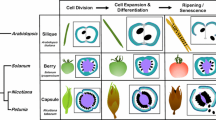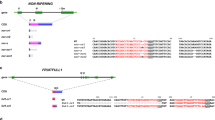Abstract
fw2.2 is one of the few QTLs thus far isolated from plants and the first one known to control fruit size. While it has been established that FW2.2 is a regulator (either directly or indirectly) of cell division, FW2.2 does not share sequence homology to any protein of known function (Frary et al. Science 289:85–88, 2000; Cong et al. Proc Natl Acad Sci USA 99:13606–13611, 2002; Liu et al. Plant Physiol 132:292–299, 2003). Thus, the mechanism by which FW2.2 mediates cell division in developing fruit is currently unknown. In an effort to remedy this situation, a combination of yeast two-hybrid screens, in vitro binding assays and cell bombardment studies were performed. The results provide strong evidence that FW2.2 physically interacts at or near the plasma membrane with the regulatory (beta) subunit of a CKII kinase. CKII kinases are well-studied in both yeast and animals where they form part of cell cycle related signaling pathway. Thus while FW2.2 is a plant-specific protein and regulates cell division in a specialized plant organ (fruit), it appears to participate in a cell-cycle control signal transduction pathway that predates the divergence of single- and multi-cellular organisms. These results thus provide a glimpse into how ancient and conserved regulatory processes can be co-opted in the evolution of novel organs such as fruit.
Similar content being viewed by others
References
Bibby AC, Litchfield DW (2005) The multiple personalities of the regulatory subunit of protein kinase CK2: CK2 dependent and CK2 independent roles reveal a secret identity for CK2beta. Int J Biol Sci 1:67–79
Boldyreff B, Issinger OG (1997) A-Raf kinase is a new interacting partner of protein kinase CK2 beta subunit. FEBS Lett 403:197–199
Boldyreff B, Mietens U, Issinger OG (1996) Structure of protein kinase CK2: dimerization of the human beta-subunit. FEBS Lett 379:153–156
Carroll SB (2000) Endless forms: the evolution of gene regulation and morphological diversity. Cell 101:577–580
Chantalat L, Leroy D, Filhol O, Nueda A, Benitez MJ, Chambaz EM, Cochet C, Dideberg O (1999) Crystal structure of the human protein kinase CK2 regulatory subunit reveals its zinc finger-mediated dimerization. EMBO J 18:2930–2940
Chen M, Cooper JA (1997) The beta subunit of CKII negatively regulates Xenopus oocyte maturation. ProcNatl Acad Sci USA 94:9136–9140
Chen M, Li D, Krebs EG, Cooper JA (1997) The casein kinase II beta subunit binds to Mos and inhibits Mos activity. Mol Cell Biol 17:1904–1912
Collinge MA, Walker JC (1994) Isolation of an Arabidopsis thaliana casein kinase II beta subunit by complementation in Saccharomyces cerevisiae. Plant Mol Biol 25:649–658
Cong B, Liu J, Tanksley SD (2002) Natural alleles at a tomato fruit size quantitative trait locus differ by heterochronic regulatory mutations. Proc Natl Acad Sci USA 99:13606–13611
Daniel X, Sugano S, Tobin EM (2004) CK2 phosphorylation of CCA1 is necessary for its circadian oscillator function in Arabidopsis. Proc Natl Acad Sci USA 101:3292–3297
Doganlar S, Frary A, Daunay MC, Lester RN, Tanksley SD (2002) Conservation of gene function in the solanaceae as revealed by comparative mapping of domestication traits in eggplant. Genetics 161:1713–1726
Espunya MC, Combettes B, Dot J, Chaubet-Gigot N, Martinez MC (1999) Cell-cycle modulation of CK2 activity in tobacco BY-2 cells. Plant J 19:655–666
Faust M, Montenarh M (2000) Subcellular localization of protein kinase CK2. A key to its function?. Cell Tissue Res 301:329–340
Fields S, Song O (1989) A novel genetic system to detect protein-protein interactions. Nature 340:245–246
Filhol O, Nueda A, Martel V, Gerber-Scokaert D, Benitez MJ, Souchier C, Saoudi Y, Cochet C (2003) Live-cell fluorescence imaging reveals the dynamics of protein kinase CK2 individual subunits. Mol Cell Biol 23:975–987
Filhol O, Martiel JL, Cochet C (2004) Protein kinase CK2: a new view of an old molecular complex. EMBO Rep 5:351–355
Frary A, Nesbitt TC, Grandillo S, Knaap E, Cong B, Liu J, Meller J, Elber R, Alpert KB, Tanksley SD (2000) fw2.2: a quantitative trait locus key to the evolution of tomato fruit size. Science 289:85–88
Frary A, Xu Y, Liu J, Mitchell S, Tedeschi E, Tanksley S (2005) Development of a set of PCR-based anchor markers encompassing the tomato genome and evaluation of their usefulness for genetics and breeding experiments. Theor Appl Genet 111:291–312
Glover CV 3rd (1998) On the physiological role of casein kinase II in Saccharomyces cerevisiae. Prog Nucleic Acid Res Mol Biol 59:95–133
Grandillo S, Tanksley SD (1999) Identifying the loci responsible for natural variation in fruit size and shape in tomato. Theor Appl Genet 99:978–987
Guerra B, Issinger OG, Wang JY (2003) Modulation of human checkpoint kinase Chk1 by the regulatory beta-subunit of protein kinase CK2. Oncogene 22:4933–4942
Hagemann C, Rapp UR (1999) Isotype-specific functions of Raf kinases. Exp Cell Res 253:34–46
Hagemann C, Kalmes A, Wixler V, Wixler L, Schuster T, Rapp UR (1997) The regulatory subunit of protein kinase CK2 is a specific A-Raf activator. FEBS Lett 403:200–202
Holm L, Sander C (1996) Mapping the protein universe. Science 273:595–603
Homma MK, Wada I, Suzuki T, Yamaki J, Krebs EG, Homma Y (2005) CK2 phosphorylation of eukaryotic translation initiation factor 5 potentiates cell cycle progression. Proc Natl Acad Sci USA 102:15688–15693
King MC, Wilson AC (1975) Evolution at two levels in humans and chimpanzees. Science 188:107–116
Klimczak LJ, Collinge MA, Farini D, Giuliano G, Walker JC, Cashmore AR (1995) Reconstitution of Arabidopsis casein kinase II from recombinant subunits and phosphorylation of transcription factor GBF1. Plant Cell 7:105–115
Kusk M, Ahmed R, Thomsen B, Bendixen C, Issinger OG, Boldyreff B (1999) Interactions of protein kinase CK2beta subunit within the holoenzyme and with other proteins. Mol Cell Biochem 191:51–58
Li D, Dobrowolska G, Aicher LD, Chen M, Wright JH, Drueckes P, Dunphy EL, Munar ES, Krebs EG (1999) Expression of the casein kinase 2 subunits in Chinese hamster ovary and 3T3 L1 cells provides information on the role of the enzyme in cell proliferation and the cell cycle. J Biol Chem 274:32988–32996
Lieberman SL, Ruderman JV (2004) CK2 beta, which inhibits Mos function, binds to a discrete domain in the N-terminus of Mos. Dev Biol 268:271–279
Litchfield DW (2003) Protein kinase CK2: structure, regulation and role in cellular decisions of life and death. Biochem J 369:1–15
Liu J, Cong B, Tanksley SD (2003) Generation and analysis of an artificial gene dosage series in tomato to study the mechanisms by which the cloned quantitative trait locus fw2.2 controls fruit size. Plant Physiol 132:292–299
Long AD, Lyman RF, Langley CH, Mackay TF (1998) Two sites in the Delta gene region contribute to naturally occurring variation in bristle number in Drosophila melanogaster. Genetics 149:999–1017
Mackay TF (1996) The nature of quantitative genetic variation revisited: lessons from Drosophila bristles. Bioessays 18:113–121
Miller JP, Lo RS, Ben-Hur A, Desmarais C, Stagljar I, Noble WS, Fields S (2005) Large-scale identification of yeast integral membrane protein interactions. Proc Natl Acad Sci USA 102:12123–12128
Moyers JS, Zhu J, Kahn CR (1998) Effects of phosphorylation on function of the Rad GTPase. Biochem J 333 (Pt 3):609–614
Munstermann U, Fritz G, Seitz G, Lu YP, Schneider HR, Issinger OG (1990) Casein kinase II is elevated in solid human tumours and rapidly proliferating non-neoplastic tissue. Eur J Biochem 189:251–257
Nastainczyk W, Schmidt-Spaniol I, Boldyreff B, Issinger OG (1995) Isolation and characterization of a monoclonal anti-protein kinase CK2 beta-subunit antibody of the IgG class for the direct detection of CK2 beta-subunit in tissue cultures of various mammalian species and human tumors. Hybridoma 14:335–339
Nesbitt TC, Tanksley SD (2002) Comparative sequencing in the genus Lycopersicon. Implications for the evolution of fruit size in the domestication of cultivated tomatoes. Genetics 162:365–379
Ohno S (1970) Evolution by gene duplication. Springer-Verlag, Berlin, New York
Orengo CA, Taylor WR (1990) A rapid method of protein structure alignment. J Theor Biol 147:517–551
Pepperkok R, Lorenz P, Jakobi R, Ansorge W, Pyerin W (1991) Cell growth stimulation by EGF: inhibition through antisense-oligodeoxynucleotides demonstrates important role of casein kinase II. Exp Cell Res 197:245–253
Romero-Oliva F, Allende JE (2001) Protein p21(WAF1/CIP1) is phosphorylated by protein kinase CK2 in vitro and interacts with the amino terminal end of the CK2 beta subunit. J Cell Biochem 81:445–452
Roussou I, Draetta G (1994) The Schizosaccharomyces pombe casein kinase II alpha and beta subunits: evolutionary conservation and positive role of the beta subunit. Mol Cell Biol 14:576–586
Tapia JC, Bolanos-Garcia VM, Sayed M, Allende CC, Allende JE (2004) Cell cycle regulatory protein p27KIP1 is a substrate and interacts with the protein kinase CK2. J Cell Biochem 91:865–879
Theis-Febvre N, Filhol O, Froment C, Cazales M, Cochet C, Monsarrat B, Ducommun B, Baldin V (2003) Protein kinase CK2 regulates CDC25B phosphatase activity. Oncogene 22:220–232
True JR, Carroll SB (2002) Gene co-option in physiological and morphological evolution. Annu Rev Cell Dev Biol 18:53–80
von Heijne G (1992) Membrane protein structure prediction. Hydrophobicity analysis and the positive-inside rule. J Mol Biol 225:487–494
Wang RL, Stec A, Hey J, Lukens L, Doebley J (1999) The limits of selection during maize domestication. Nature 398:236–239
Zhang C, Vilk G, Canton DA, Litchfield DW (2002) Phosphorylation regulates the stability of the regulatory CK2beta subunit. Oncogene 21:3754–3764
Acknowledgements
We thank Drs. Jian Hua, Peter Moffett, Michael Purugganan and Haiyang Wang for critical comments on the manuscripts, and Chenwei Lin for technical assistance. This work was supported by grants from the National Research Initiative Cooperative Grants Program, U.S. Department of Agriculture Plant Genome Program (no. 9701552); the National Science Foundation (no. 0116076); and the Binational Agricultural Research and Development Fund (no. IS-3337-02).
Author information
Authors and Affiliations
Corresponding author
Rights and permissions
About this article
Cite this article
Cong, B., Tanksley, S.D. FW2.2 and cell cycle control in developing tomato fruit: a possible example of gene co-option in the evolution of a novel organ. Plant Mol Biol 62, 867–880 (2006). https://doi.org/10.1007/s11103-006-9062-6
Received:
Accepted:
Published:
Issue Date:
DOI: https://doi.org/10.1007/s11103-006-9062-6




